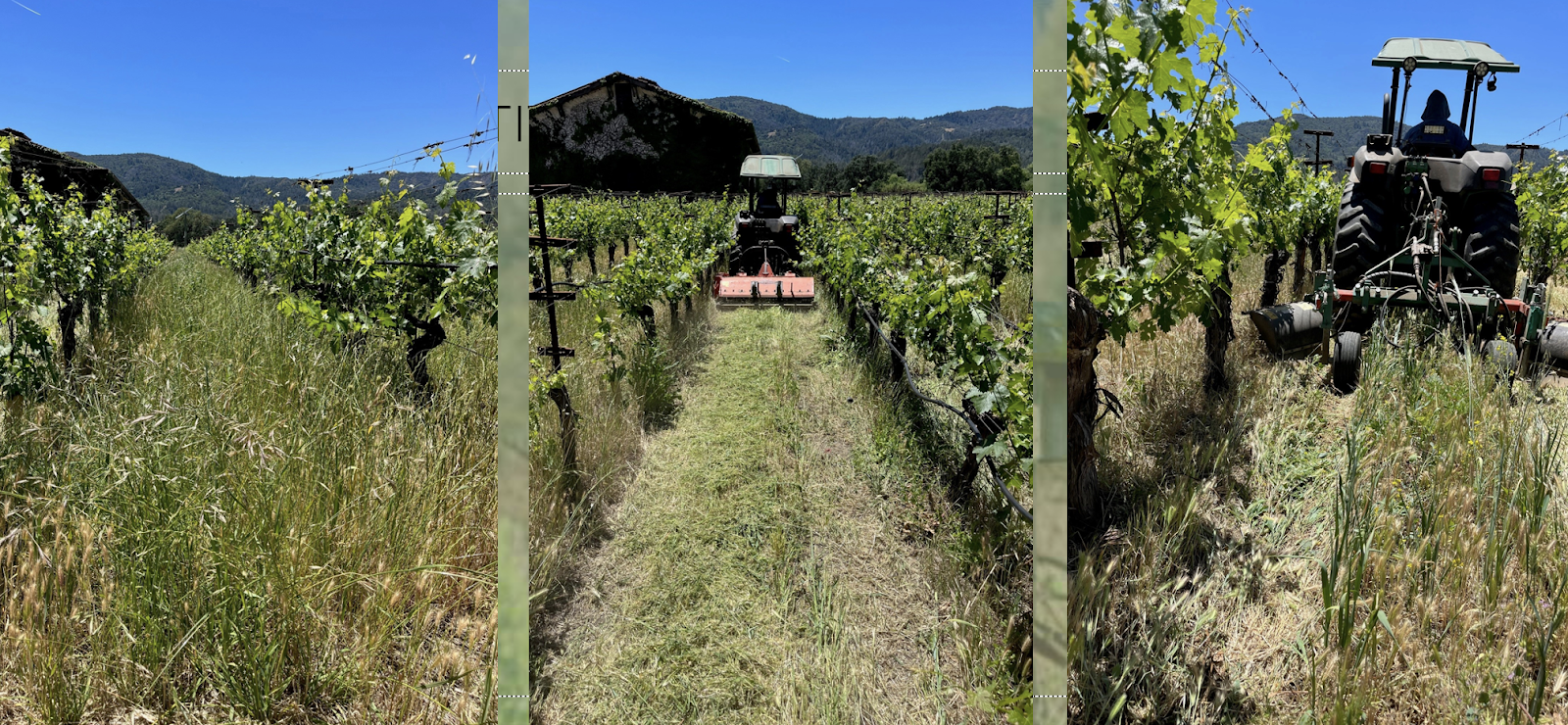We let the sheep eat about only 50% of grass. As we learned in high school, photosynthesis creates carbohydrates. When we graze only 50%, we allow the grass roots to create the exudates that microbes feed on in the soil. So the cover crop feeds the microbes. This is symbiosis between plants and microbes.
If you overgraze, that can limit the effectiveness of the cover crop to produce root exudates and feed the microbes.
Then, depending on the year, we have to mow the grass two or three times. It cost less than $250 so that's it. That is all the costs for handling grass.
We mow and mulch. If you follow this guy on the tractor, you will see he is leaving two inches of mulch that is the cut down cover crop and grasses. Why is this important?

On a 90 degree day, if you measure the surface temperature of the bare soil, it will be 150 degrees. Biology dies at 110 degrees, so a bare soil sitting in the sun will lose all life a few inches down.
At that temperature, you kill all the microbes. So there will be no more microbes.
WATER
Secondly, all the water in the first few inches of soil is evaporating. When surface water evaporates, more moisture is brought up by the capillary action of the plant and evaporated again. This is how we lose precious soil moisture.
So it's a myth that clean cultivation saves water.
In our system, mulching lowers the natural ambient soil temperature a few inches down. If it’s 90 degrees outside, the soil under the mulch will be maybe 86 degrees.
SOIL HEALTH
We always knew that we needed healthy soil for the best grapes and for longevity.
We are a family owned business. We want to keep it independent for a few more generations.
Many farmers look at only a three to five year business plan. We're looking 50-100 years into the future for our business plan.
When we started farming, we knew that we had to produce high quality grapes. Without high quality grapes, there's no high quality wine. And we just discovered that contrary to popular belief, you can save money and farm responsibly in agriculture.
Basically we have to change our mindset.
How do we enhance soil organic matter, through managing cover crops, sheep and microbes in the soil?
At Grgich, in order to enhance organic soil matter we plant a cover crop and add compost every year. It took us 15 years to gain a 1% increase in soil organic matter. This is too slow.
My misconception was that healthy soil produces healthy plants. Actually, it is quite the opposite. You need to have healthy plants as cover crops, and you have to cover the soil all year round, because not growing plants in your soil will reduce the carbohydrates that feed the microbes.
Microbes are the bacteria and fungi living near the roots of plants. We stopped tilling our soil to enhance the population of fungi which, through fungal digestion, builds up soil organic matter much quicker. Do not destroy fungi, because they create humus which is extremely beneficial.
Since we became “lazy famers,” (since we do not mow our vineyard rows) we now have quadrupled the amount of insects–including ladybugs– that are feeding on the mealybugs. Yet some people say, “Oh my God, these guys have not done their job because the vineyard has weeds in it and looks wild.” But we are increasing the health of the soil.
So besides increasing microbial diversity and the number of microbes, I can prepare food for plants in the form of biostimulants and foliar sprays. That is better versus ionic nitrogen, phosphorus, and potassium additions people add to their soils. In moderation, these sprays can help keep the plant growing healthy and strong and encourage it to use the nutrients that are already in the soil. This helps make the plant less reliant on our sprays and more reliant on the already present nutrients in the soil.
Just imagine, because of great plant nutrition and health, the grapevines will produce a much thicker waxy coat called a cuticle on the berry. This provides extra resistance against mildew and possibly smoke taint. So by improving the health of microbes and potentially doing some foliar sprays, some pests will not be as big of a problem. You're making it harder for pests.
In our business, we are growing grapes not just for brix–but for the secondary metabolites–phenols, anthocyanins–that we want to make great wine. It's these secondary metabolites that also generate the healthiest crop. They are good for our health and also good for the quality of our wine.











